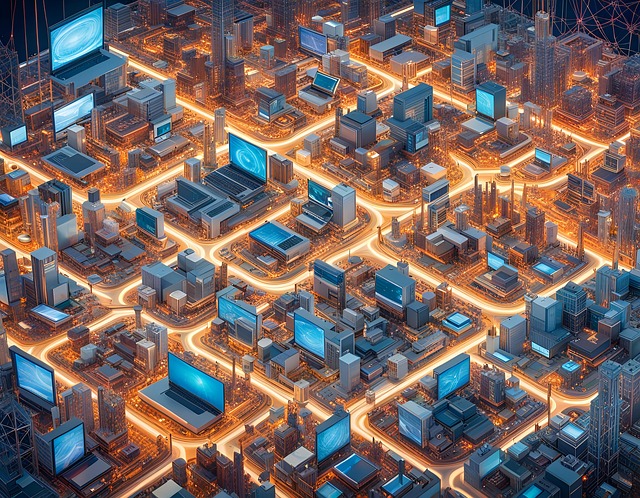In the digital era, consumers demand transparency in their food sources, especially seafood. Traditional tracking methods are inadequate, prompting the need for innovative solutions like AI seafood freshness monitoring systems. These cutting-edge tools ensure product quality and provenance with unmatched precision and efficiency by tracking seafood from source to plate. They collect real-time data using sensors and IoT devices, analyze it through advanced algorithms (including machine learning), predict spoilage, identify quality issues, and locate contamination sources proactively. By doing so, these systems guarantee only the highest quality seafood reaches customers, revolutionizing industry monitoring. Integrating AI into seafood restaurant operations offers numerous advantages, including precise catch tracking, minimizing waste, enhancing customer satisfaction, and predicting demand patterns for optimized supply chains and personalized menu recommendations.
In the rapidly evolving landscape of hospitality, ensuring fresh catch in seafood restaurants is paramount. Enter AI seafood freshness monitoring systems, revolutionary tools that promise to transform the industry. This article delves into the urgent need for such systems, exploring their key components and highlighting the profound benefits and future implications they hold. By harnessing artificial intelligence, these innovations are set to redefine how seafood restaurants manage their fresh catch, revolutionizing both operations and customer experiences.
- Understanding the Need for AI Seafood Freshness Monitoring Systems
- Key Components of an Effective AI-Powered Fresh Catch Tracking System
- Benefits and Future Implications of AI in Seafood Restaurant Operations
Understanding the Need for AI Seafood Freshness Monitoring Systems

In today’s digital era, consumers increasingly demand transparency and traceability in their food sources, especially when it comes to seafood. Traditional tracking methods for fresh catch often fall short, leading to a pressing need for innovative solutions. This is where AI seafood freshness monitoring systems step in as game-changers, revolutionizing the way we ensure the quality and provenance of our meals.
By leveraging advanced artificial intelligence, these systems offer an unparalleled level of precision and efficiency. They can track seafood from its source all the way to the plate, providing real-time data on temperature, humidity, and transportation conditions. This not only helps restaurants maintain the highest standards of freshness but also empowers them to make data-driven decisions, ultimately enhancing customer satisfaction and building trust in their offerings.
Key Components of an Effective AI-Powered Fresh Catch Tracking System

An effective AI-powered fresh catch tracking system relies on several key components. Firstly, real-time data collection through sensors and IoT devices is crucial. These tools monitor parameters like temperature, humidity, and oxygen levels in seafood storage facilities and transportation vessels. By capturing precise, continuous data, the system can detect any deviations from optimal conditions that could compromise seafood freshness.
Secondly, advanced algorithms play a vital role in analyzing this data. Machine learning models can predict spoilage rates, identify patterns indicative of quality degradation, and pinpoint potential sources of contamination. Integrating these algorithms into the tracking system enables proactive measures to maintain seafood freshness, ensuring that only the highest quality products reach customers.
Benefits and Future Implications of AI in Seafood Restaurant Operations

The integration of AI into seafood restaurant operations offers a plethora of advantages, revolutionizing the way fresh catch is tracked and ensuring optimal quality. AI seafood freshness monitoring systems can precisely predict the ideal time for fish to be delivered from the market, minimizing the risk of spoilage. By analyzing historical sales data and real-time inventory levels, these systems ensure that only the freshest seafood is served, enhancing customer satisfaction.
Looking ahead, the future implications of AI in this sector are promising. These intelligent systems can predict demand patterns, enabling restaurants to optimize their supply chain and reduce waste. Additionally, they can facilitate personalized menu recommendations based on customer preferences and dietary requirements, creating a unique dining experience. As AI continues to evolve, seafood restaurants can leverage these technologies to stay competitive, maintain high standards, and cater to diverse consumer needs in the digital age.
AI seafood freshness monitoring systems represent a revolutionary approach to ensuring the quality and sustainability of ocean-farmed products. By leveraging advanced technologies, these systems not only enhance customer satisfaction through consistent fresh catches but also contribute to environmentally responsible practices in the seafood industry. As AI continues to evolve, its integration into restaurant operations promises to streamline processes, reduce waste, and offer unprecedented transparency, setting a new standard for culinary excellence and ecological stewardship.
